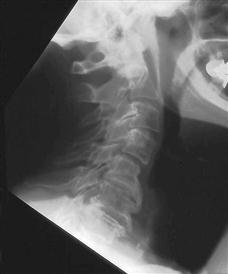Neck Pain
Neck pain is a common problem. The majority of cases are due to poor posture or cervical spondylosis. If there has been a history of trauma, extreme care must be exercised in examination of the neck and any X-rays must be strictly supervised.
History
Congenital
Torticollis may be congenital and present at birth due to sternomastoid ‘tumour’. This is a rare condition often associated with breech delivery. Klippel–Feil syndrome is rare and is characterised by developmental abnormalities of the cervical vertebrae and a high-riding scapula.
Acquired
Traumatic
History of trauma may be evident and it is important to screen for any neurological sequelae, e.g. arm pain or weakness or bladder symptoms. Whiplash injuries are common. These occur in road traffic accidents where the car is struck from behind. The neck extends with sudden acceleration and flexes forward with sudden deceleration.
Inflammatory
Rheumatoid arthritis frequently affects the neck, particularly the atlantoaxial joints, which may undergo subluxation. There will usually be a history of rheumatoid arthritis elsewhere. The patient complains of pain in the neck, difficulty in walking and there may be progressive bladder involvement.
Degenerative
Cervical spondylosis is the commonest condition involving the neck. The patient complains of neck pain and stiffness with radiation of pain into the occiput, shoulder or arms. There may be complaints of weakness of grip and wasting of the hand. Acute cervical disc lesions may cause acute neck pain, with referred pain to the arm with weakness. Central disc protrusion may cause bladder problems or even paraplegia.
Neoplastic
Primary tumours of the cervical vertebrae are extremely rare. Secondary deposits may occur from breast, bronchus, lung, prostate or kidney. The patient may have had surgery for carcinoma of one of these organs. If not, check for a history suggesting a lesion. The patient will present with pain and collapse of a vertebra, perhaps with neurological symptoms.
Other
Postural neck pain is common and relates to changes in neck posture, the patient often complaining of sleeping in an ‘awkward’ position. The pain is usually across the neck and shoulders. The patient may also complain of exposure to cold, e.g. ‘sitting in a draught’. Meningitis may cause a stiff neck with pain, as does subarachnoid haemorrhage. The diagnosis of these will usually be obvious from the history. The headache radiates into the neck and causes neck stiffness.
Examination
Congenital
Torticollis – the head is pulled down to the affected side and often rotated to the opposite side. Klippel–Feil syndrome presents with a short neck and a high-riding scapula.
Acquired
Traumatic
Treat the patient as for spinal injury, with stabilisation of the neck. Carry out a full neurological examination. Any X-ray examination should be strictly supervised by an experienced orthopaedic surgeon. With whiplash injuries, there is usually only ligamentous and soft-tissue damage. Localised tenderness may be present. Check for pain and paraesthesia in the arms and hands.
Inflammatory
Rheumatoid arthritis will be apparent elsewhere, e.g. hand deformities, ulnar deviation. Carry out a full neurological examination.
Infective
With TB, the patient will be generally unwell with spasm in the neck muscles. There may be evidence of paravertebral abscess. Carry out a full neurological examination.
Degenerative
There will be reduced neck movements. Carry out a full neurological examination. There will often be weakness of grip, muscle wasting and reduced reflexes. Acute disc lesions result in pain and spasm of the neck muscles. There may be weakness of the arm and reduced reflexes. Carry out a full neurological examination.
Neoplastic
Examine the possible sites of primary tumours, e.g. breast, bronchus, prostate, thyroid, kidney. Carry out a full neurological examination.
Other
With postural neck pain or cold exposure, there is usually little to find on examination. There may be some localised muscular tenderness. With meningitis, the patient is usually ill, with photophobia, headache, stiff neck and a positive Kernig’s sign. Subarachnoid haemorrhage is usually diagnosed from the history.
General Investigations
■ FBC, ESR
Hb ↓ anaemia of chronic disease, e.g. rheumatoid arthritis. WCC ↑ infection. ESR ↑ rheumatoid arthritis, TB, malignancy.
■ Rheumatoid factor
Rheumatoid arthritis.
■ X-ray
Fractures (supervised X-rays), cervical spondylosis – narrowing of joint spaces, osteophytes. Rheumatoid arthritis – atlantoaxial subluxation. Secondary deposits. Congenital anomalies.





